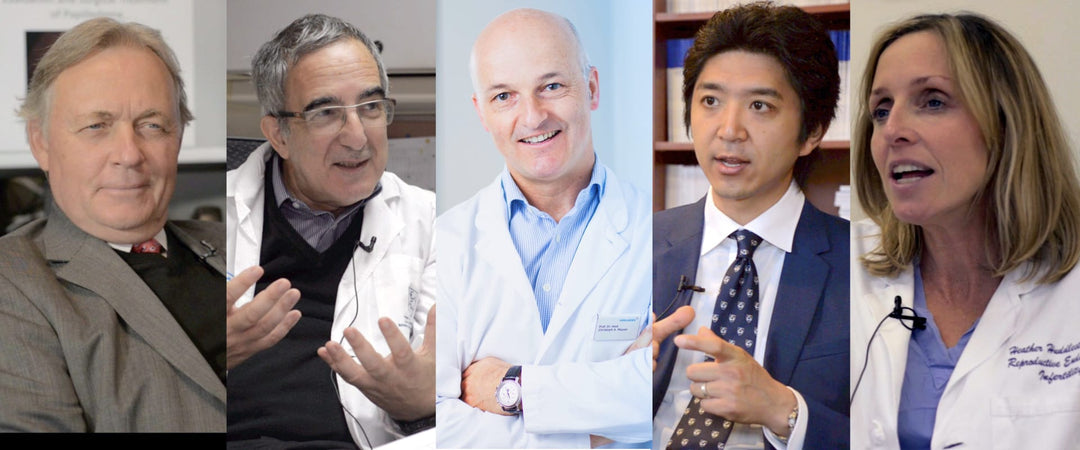Silmissä erikoistuneen lääketieteen tohtori Dominique Bremond-Giginacin, harvinaisten silmäsairauksien johtavan asiantuntijan, esittelemässä tapausselostuksessa perusteellinen potilaan anamneesi ja kliininen fenotyyppianalyysi johtivat Kimuran taudin toteamiseen 8-vuotiaalla pojalla, jolla havaittiin epätavallisia sidekalvokasvaimia. Tämä korostaa lääkäri-potilassuhteen ratkaisevaa merkitystä monimutkaisten diagnoosien saavuttamisessa.
Miten perinpohjainen lääketieteellinen anamneesi paljasti harvinaisen Kimuran taudin diagnoosin lastensilmätautien erikoisalalla
Hyppää osioon
- Epätavalliset sidekalvokasvaimet 8-vuotiaalla pojalla
- Epätyypillisen Kimuran taudin diagnostinen haaste
- Ratkaiseva johtolanka perheen lääketieteellisestä historiasta
- Kirurginen hoito ja pitkän aikavälin ennuste
- Keskeisiä opetuksia silmälääkäreille ja lastenlääkäreille
- Miksi kattava fenotypointi on tärkeää harvinaisissa sairauksissa
- Koko transkriptio
Epätavalliset sidekalvokasvaimet 8-vuotiaalla pojalla
Lääketieteen tohtori Dominique Bremond-Gignac kertoo merkittävästä tapauksesta, jossa 8-vuotiaalle pojalle lähetettiin tutkimuksiin näennäisesti tavallisen sidekalvotulehduksen vuoksi. Potilaalla oli kuitenkin bilateraliset sidekalvokasvaimet epätavallisilla piirteillä: verisuonistuneet, tummuneet granuloomat, jotka olivat edenneet 6–8 kuukauden ajan. Tämä epätyypillinen oirekuva herätti välittömästi hälytyskellot kokeneella silmälääkärillä tertiäärisessä hoitokeskuksessa.
Tapaus erottui tyypillisistä sidekalvotulehduksista, joita harvoin lähetetään erikoislääkärin arvioitavaksi. Nämä kasvaimet kuitenkin osoittivat huolestuttavia piirteitä. Lääketieteen tohtori Dominique Bremond-Gignac korostaa, että tällaiset odottamattomat löydökset rutiinitapauksissa viittaavat usein taustalla oleviin harvinaisiin sairauksiin, jotka vaativat asiantuntija-arviointia.
Epätyypillisen Kimuran taudin diagnostinen haaste
Kliininen kuva esitti useita diagnostisia haasteita. Kimuran tauti vaikuttaa tyypillisesti aasialaiseen väestöön, eikä sitä pidetä geneettisenä. Tämä potilas oli kuitenkin normandialaista syntyperää ja vain osittain aasialaista alkuperää äitinsä kautta. Sairaus ilmenee yleensä sylkirauhasissa silmäkudosten sijaan, mikä teki tästä sidekalvojen esiintymisestä poikkeuksellisen harvinaisen.
Lääketieteen tohtori Dominique Bremond-Gignac huomauttaa, että ilman perinpohjaista anamneesia patologi olisi saattanut jäädä kokonaan havaitsematta Kimuran taudin. Tapaus korostaa, miten harvinaiset sairaudet voivat ilmetä odottamattomin tavoin, vaatien lääkäreiltä laajaa diagnostista harkintaa.
Ratkaiseva johtolanka perheen lääketieteellisestä historiasta
Diagnostinen läpimurto tapahtui, kun tohtori Bremond-Gignac huomasi isällä epätavalliset kasvonpiirteet ja tiedusteli tämän terveyshistoriaa. Isä paljasti, että häneltä oli poistettu molemmat parotidirauhaset Kimuran taudin vuoksi 11-vuotiaana – tieto, josta tuli ratkaiseva pojan tapauksen selvittämisessä.
Tämä vuorovaikutus osoittaa, miten lääkärin tarkkaavaisuus ja perusteellinen perhehistorian tiedustelu voivat paljastaa ratkaisevia diagnostisia yhteyksiä. Isän sairaus, vaikkei klassisesti geneettinen, viittasi mahdolliseen perinnölliseen komponenttiin tässä epätyypillisessä tapauksessa.
Kirurginen hoito ja pitkän aikavälin ennuste
Tohtori Bremond-Gignac eteni molempien sidekalvokasvainten kirurgiseen poistoon, ja histopatologinen tutkimus vahvisti Kimuran taudin. Lapsella kehittyi myöhemmin munuaissairaus, joka on tunnettu systeeminen ilmentymä, ja vaati intensiivistä hoitoa.
Vaikka tapauksella oli vakavat seuraukset, oikea diagnoosi mahdollisti asianmukaisen seurannan ja hoitojen aloittamisen. Tohtori Bremond-Gignac korostaa, että ajoissa tehty diagnoosi vaikuttaa merkittävästi harvinaisten sairauksien ennusteeseen. Näille sairauksille on usein olemassa hoitoprotokollat, mutta ne eivät välttämättä ole laajalti tunnettuja.
Keskeisiä opetuksia silmälääkäreille ja lastenlääkäreille
Tämä tapaus tarjoaa useita käytäntöä muuttavia oivalluksia. Ensinnäkin hoidolle vastaamaton pysyvä "sidekalvotulehdus" vaatii erikoislääkärin arviointia. Toiseksi epätavalliset silmälöydökset tulisi herättää perusteellinen systemaattinen ja perhehistorian tarkastelu. Kolmanneksi harvinaiset sairaudet voivat ilmetä tyypillisen demografisen tai anatomialuokan ulkopuolella.
Lääketieteen tohtori Dominique Bremond-Gignac korostaa, että potilaiden ja perheiden kanssa vietetty ylimääräinen aika tuottaa usein kriittistä diagnostista tietoa, jota laboratoriotestit eivät yksinään pysty tarjoamaan.
Miksi kattava fenotypointi on tärkeää harvinaisissa sairauksissa
Lääketieteen tohtori Dominique Bremond-Gignac korostaa tätä tapausta ensisijaisena esimerkkinä kliinisestä fenotypoinnista – systemaattisesta kaikkien fyysisten ominaisuuksien ja oireiden dokumentoinnista ennen geneettisten testien aloittamista. Harvinaisissa sairauksissa tarkka fenotypointi ohjaa asianmukaista geneettistä analyysiä ja estää väärän diagnoosin.
Lääketieteen tohtori Dominique Bremond-Gignac päättelee, että lääkärin ja potilaan välinen kommunikaatio pysyy tehokkaimpana diagnostisena työkaluna, erityisesti harvinaisten sairauksien kuten Kimuran taudin epätyypillisissä esiintymisissä. Tämä lähestymistapa varmistaa, että potilaat saavat tarkat diagnoosit ja asianmukaiset hoidot jopa poikkeuksellisen harvinaisille ilmenemismuodoille.
Koko transkriptio
Lääketieteen tohtori Anton Titov: Onko sinulla potilastarinaa, jota voisit käsitellä havainnollistaaksesi joitakin tänään käsitellyistä aiheista? Mainitsit yhden verisuonistukseen liittyvän potilastarinan, joka oli hyvin mielenkiintoinen. Sinulla oli kokonainen sarja potilaita. Onko muita potilastarinoita, joita haluaisit jakaa katsojiemme kanssa?
Lääketieteen tohtori Dominique Bremond-Gignac: Ajattelen potilastarinoita päivittäin. Tarinoita on monia, mutta aika ei riitä kaikkien kertomiseen. Jaan yhden potilastarinan, joka heijastaa jokapäiväistä käytäntöämme, sillä jokainen potilas on oma tarinansa. Joskus diagnoosi on melko helppo, mutta toisinaan kliininen tapaus vaatii pitkään ratkaisua.
Minulle lähetettiin kahdeksanvuotias poika sidekalvotulehduksen vuoksi. Kun näin sidekalvotulehduksen, se oli epätavallinen – tyypillisesti niitä ei lähetetä tertiäärisiin keskuksiin, koska ne hoidetaan yleensä helposti. Tällä lapsella oli kuitenkin kaksi kasvainta molempien silmien sidekalvossa. Se oli ensimmäinen kerta, kun olin nähnyt sellaista.
Hänen isänsä oli paikalla, ja kasvaimet näyttivät verisuonistuneilta mutta hyvin omituisilta, kuin tummuneilta granuloomoilta. Keskustelin isän kanssa, joka kertoi kasvainten kasvaneen kuudesta kahdeksaan kuukautta, ensin toisessa silmässä ja sitten toisessa. Kysyin, onko lapsella muita ongelmia, ja isä vastasi ei.
Sitten huomasin, että isällä oli omituinen kasvonilme. Kysyin, onko hänellä mitään terveysongelmia. Hän vastasi: "Kyllä, minulta poistettiin molemmat parotidirauhaset 11-vuotiaana. Äitini kertoi, että minulla oli Kimuran tauti."
Kimuran tautia ei pidetä geneettisenä, ja se esiintyy tyypillisesti aasialaisilla potilailla. Tämä perhe oli Normandiasta, vaikka äiti oli Aasiasta. Keskustelimme tilanteesta, ja poistin molemmat kasvaimet lapselta. Diagnoosiksi vahvistui Kimuran tauti.
Kun käyttää aikaa vanhempien kyselyyn ja keskusteluun heidän kanssaan, voi ratkaista ongelmia. Tämä lapsi kehitti myöhemmin munuaisongelmia ja vaati raskasta hoitoa, mutta hänellä menee nyt hyvin. Oikean diagnoosin saaminen oli erittäin tärkeää.
Tämä tapaus havainnollistaa, kuinka kriittistä on saada täydellinen kliininen historia. Ilman isän historiaa patologi ei olisi välttämättä diagnosoinut Kimuran tautia niin helposti. Kyse ei ole pelkästään patologiasta tai kirurgiasta – vaaditaan taitava asiantuntija, joka tuntee harvinaiset sairaudet, jotta diagnoosit tehdään ajoissa.
Meidän on käytettävä aikaa potilaiden kanssa, keskusteltava heidän kanssaan ja perusteltava huolellisesti kaikki merkit ja oireet ennen genotyypitykseen siirtymistä. Kaikki nämä vaiheet ovat erittäin tärkeitä diagnosoinnissa ja hoidossa.
Lääketieteen tohtori Anton Titov: Kiitos, professori Dominique Brémond-Gignac. Onko aihetta tai kysymystä, jota en kysynyt mutta olisin pitänyt kysyä? Onko mitään muuta kokemuksestasi, jonka haluaisit jakaa?
Lääketieteen tohtori Dominique Bremond-Gignac: Ei, luulen, että olemme täällä parantaaksemme potilaita, hoitamaan heitä ja tarjoamaan kliinisiä hoitosuosituksia sairauksille, joista tiedämme enemmän kuin toiset. Meidän tulisi jatkaa tätä lähestymistapaa potilaille.
Lääketieteen tohtori Anton Titov: Kiitos paljon tästä erittäin mielenkiintoisesta keskustelusta! Toivomme puhuvamme kanssasi tulevaisuudessa edistymisestä geeniaterapiassa tavallisessa likitaipoisuudessa, likinäköisyydessä, verkkokalvosairauksissa ja etusilmän ongelmissa. Aiheita on niin paljon keskusteltavaksi! Arvostan suuresti tätä keskustelua, ja olen varma, että kaikki pitävät siitä hyvin hyödyllisenä. Kiitos paljon!
Lääketieteen tohtori Dominique Bremond-Gignac: Kiitos, Anton. Jatkamme eteenpäin!





